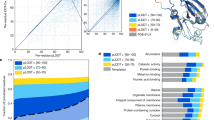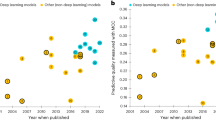Abstract
One of the most tantalising ‘grand challenges’ in structural biology is to solve the problem of predicting the structure of a protein from its amino acid sequence alone. Although this problem appeals to many researchers on a purely academic level, the practical importance of protein structure prediction has become particularly clear with the release of the first draft of the complete human genome sequence last year. This moved modern biology into the new so-called ‘post genome’ era, and for the foreseeable future, one of the main issues in modern biology will be the characterisation of the many ‘unknown’ gene sequences which are now sitting waiting in DNA and protein data banks. Protein structure can provide a great deal of insight into the evolutionary origins, function and mechanism of a protein, and so any means for determining the 3-D structure of a novel protein will likely be of critical importance.
This is a preview of subscription content, access via your institution
Access options
Subscribe to this journal
Receive 6 print issues and online access
$259.00 per year
only $43.17 per issue
Buy this article
- Purchase on Springer Link
- Instant access to full article PDF
Prices may be subject to local taxes which are calculated during checkout

Similar content being viewed by others
References
Shortle D . Protein fold recognition Nature Struct Biol 1995 2: 91–93
Eisenberg D . In the black of night Nature Struct Biol 1997 4: 95–97
Koehl P, Levitt M . A brighter future for protein structure prediction Nature Struct Biol 1999 6: 108–111
Proteins 1995 23
Proteins 1997 Suppl 1
Proteins 1999 Suppl 3
Altschul SF, Madden TL, Schaffer AA, Zhang JH, Zhang Z, Miller W et al . Gapped BLAST and PSI-BLAST: a new generation of protein database search programs Nucleic Acids Res 1997 25: 3389–3402
Eddy SR . Hidden Markov models Bioinformatics 1998 14: 755–763
Murzin AG, Brenner SF, Hubbard T, Chothia C . SCOP: a structural classification of proteins database for the investigation of sequences and structures J Mol Biol 1995 297: 536–540
Fischer D, Bryson K, Elofsson A, Godzik A, Jones D, Karplus K et al . CAFASP-1: Critical assessment of fully automated structure prediction methods Proteins 1999 Suppl 3: 209–217
Rost B . PHD: predicting one-dimensional protein structure by profile-based neural networks Meth Enzymol 1996 266: 525–539
Fischer D, Eloffson A, Rychlewski L . The 2000 Olympic Games of protein structure prediction; fully automated programs are being evaluated vis-a-vis human teams in the protein structure prediction experiment CAFASP2 Protein Eng 2000 13: 667–670
Murzin AG . Structure classsification-based assessment of CASP3 predictions for the fold recognition targets Proteins 1999 S3: 88–103
Lackner P, Koppensteiner WA, Domingues F, Sippl MJ . Automated large scale evaluation of protein structure predictions Proteins 1999 S3: 7–14
Jones DT . Protein secondary structure prediction based on position-specific scoring matrices J Mol Biol 1999 292: 195–202
Jones DT . Successful ab initio prediction of the tertiary structure of NK-lysin using multiple sequences and recognized supersecondary structural motifs Proteins 1997 Suppl 1: 185–191
Simons KT, Bonneau R, Ruczinski I, Baker D . Ab initio protein structure prediction of CASP III targets using ROSETTA Proteins 1999 37 S3: 171–176
Aszodi A, Gradwell MJ, Taylor WR . Global fold determination from a small number of distance restraints J Mol Biol 1995 251: 308–326
Bowers PM, Strauss CE, Baker D . De novo protein structure determination using sparse NMR data J Biomol NMR 2000 18: 311–318
Young MM, Tang N, Hempel JC, Oshiro CM, Taylor EW, Kuntz ID et al . High throughput protein fold identification by using experimental constraints derived from intramolecular cross-links and mass spectrometry Proc Natl Acad Sci USA 2000 97: 5802–5806
Author information
Authors and Affiliations
Rights and permissions
About this article
Cite this article
Jones, D. Critically assessing the state-of-the-art in protein structure prediction. Pharmacogenomics J 1, 126–134 (2001). https://doi.org/10.1038/sj.tpj.6500017
Received:
Revised:
Accepted:
Published:
Issue Date:
DOI: https://doi.org/10.1038/sj.tpj.6500017



